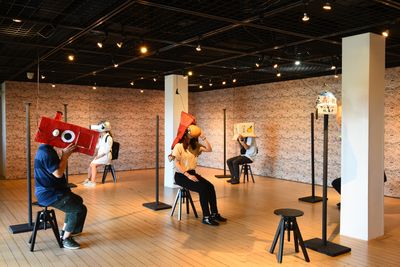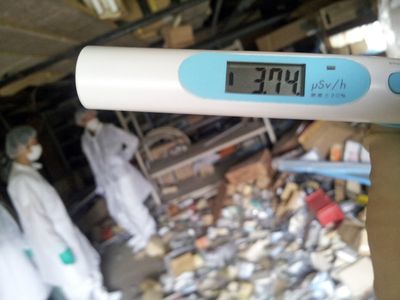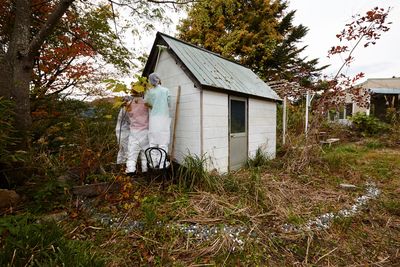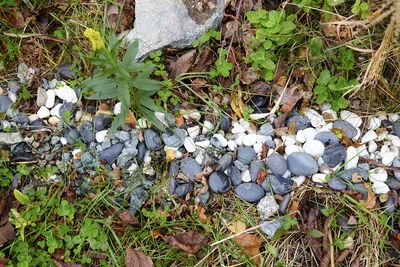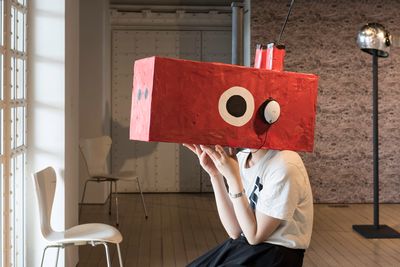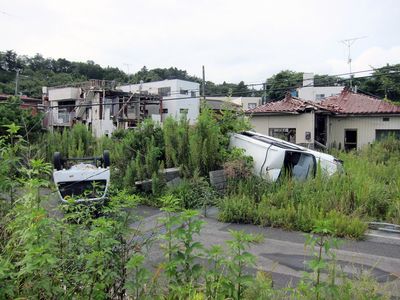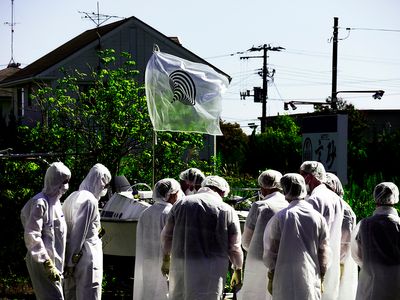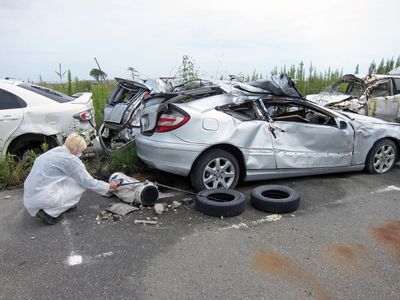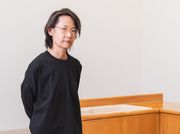Jason Waite
Courtesy Jason Waite. Photo: Sohin Hwang.
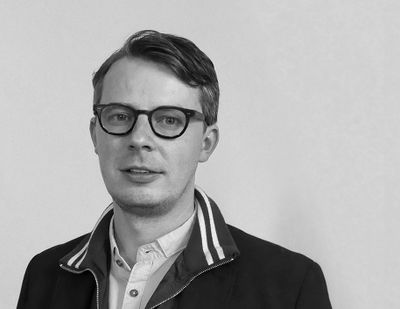
Courtesy Jason Waite. Photo: Sohin Hwang.
Jason Waite is an independent curator and cultural worker focused on forms of artistic practice producing self-organisation. Working in sites of crisis amidst the detritus of capitalism, Waite is looking for tools and radical imaginaries of very different ways of living and working together. He is part of the collective Don't Follow the Wind, along with Kenji Kubota, Eva and Franco Mattes, and Chim↑Pom, who initiated the eponymous ongoing project inside the uninhabited Fukushima exclusion zone.
Don't Follow the Wind (2015) was an exhibition comprising newly commissioned works by 12 artists and teams installed inside homes and structures loaned by former residents of the zone, and at the Watari Museum in Tokyo. The show included collaborations with Ai Weiwei, Chim↑Pom, Grand Guignol Mirai, Nikolaus Hirsch and Jorge Otero-Pailos, Meiro Koizumi, Eva and Franco Mattes, Aiko Miyanaga, Ahmet Öğüt, Trevor Paglen, Taryn Simon, Nobuaki Takekawa and Kota Takeuchi. It opened in March 2015 on the fourth anniversary of the earthquake and tsunami that triggered the ongoing crisis, but the general public will not be able to physically see the exhibition until the government increases access to the area, which may take decades.
At the current 6th Yokohama Triennale, Islands, Constellations and Galapagos (4 August–5 November 2017), the collective presents A Walk in Fukushima (2016–17), an immersive 360-degree video filmed in and around the uninhabited radioactive area. The video follows the account of a former resident's visit to his abandoned home and offers an intimate experience of the inaccessible zone, the venues for the exhibition Don't Follow the Wind, and the power plant itself. It is shown on headsets made by three generations of a Fukushima family living just outside of the zone in a contaminated area deemed 'safe to live' by the government. In another project in Athens, the collective Don't Follow the Wind also developed a 'Forcibly Displaced Forum' in collaboration with refugees, former Fukushima residents and Greeks displaced by the economic crisis.
Waite is presently based between Oxford and Tokyo. Jens Maier-Rothe spoke with him about Don't Follow the Wind and what art does in zones of catastrophe.
JMI hated nuclear power as a child. When Chernobyl happened, Nutella was banned from our household because its hazelnut farms in Northern Turkey became contaminated by winds blowing from the Ukraine. The Soviet regime and media downplayed the ravaging impact for quite some time before it became a global concern. Something similar happened with the catastrophe at the Fukushima Dai-ichi Nuclear Power Plant in 2011; only this time it was on the public radar for just a year or two before vanishing again, at least in the West. Don't Follow the Wind reminds us of the unbroken urgency of the incident and defies its disappearance from mainstream media. How did the collective come together and what were your primary motives to launch the project?
JWDiscussions on the project began in 2012, precisely in this period you mentioned when media coverage of Fukushima was starting to wane yet the catastrophe was and is ongoing. This is one of the fundamental conditions that the project faces—how to maintain urgency around questions of contamination and displacement happening right now that will also continue for decades.
I met Ryuta Ushiro of Chim↑Pom in New York in December 2012, who had previously undertaken groundbreaking work in Fukushima after the disaster. My research was centred around forms of working and living together in the detritus of capitalism and Chim↑Pom was interested in doing something long term in the zone, such as large street art interventions. We spoke at length about ways to approach an indefinite exhibition. I was very much opposed to the use of spectacle in addressing Fukushima: spectacle that is intended to be consumed—all too easily forgotten. Could there be different ways to contend with the durational challenges of the long-term ongoing disaster?
Rather, I was advocating for a practice that adopts the conditions of the catastrophe in order to struggle against it. If, for instance, nuclear contamination is invisible, what if an exhibition also remained invisible for the duration of contamination? What other capacities does the negation of image ask us to imagine? If there is a media regression or even repression on Fukushima, what if information about an exhibition circulated in a different form, such as rumour? Chim↑Pom had previously done important incursions into the zone with a uniquely anarchic energy, however the conditions of even gaining access to the zone and starting something durational required a different methodology. These discussions at the beginning still resonate through the project today.
I mentioned to Ryuta my methodology of co-curatorial collaboration on each project I undertake, which both extends and challenges the thinking around the project while also sharing the labour of production. Chim↑Pom recommended working with Kenji Kubota, an independent curator based in Tokyo who had organised cultural workers providing relief support in the aftermath of the crisis and had just started heading up a new interdisciplinary research programme at the University of Tsukuba. We all met in Japan in the spring of 2013 to discuss what it would mean to undertake an exhibition in the zone. Again, here the form of embracing the inaccessibility became an important point that the exhibition turned around. When Eva and Franco Mattes invited Chim↑Pom to The Influencers Festival in Barcelona in 2013, we discussed the project with them based on their experience with Chernobyl and we asked them to join the curatorial team. Chim↑Pom brought together a network of friends, advisors, and supporters who have been a critical part of undertaking the project.
As we spent more time with former residents who shared their own ways of responding to the disaster, this helped to provide the toolkit for ways of working. For example, the role of rumour was central to the former residents' decisions in the aftermath. How could informal modes of sharing knowledge extend out when official channels were not functioning or not providing trustworthy information? Existing bonds of friendship and a radical altruism that helped to share knowledge became critical to the project. When it opened on the fourth anniversary, on 11 March 2015, a simple blank website was launched with no texts or documentation, except an audio track with all of the participants describing the mission of the project in English and Japanese. In a way, the project itself became another rumour.
JMHow did you arrive at the list of 12 artists who were commissioned to produce new works for the first exhibition? And why did it take four years to develop?
JWWe spent about a year getting to know former residents who were displaced across the prefecture of Fukushima and elsewhere. Many were concerned about the dwindling attention to the precarious living conditions in new towns or temporary housing, which at times consisted of prefab containers where some had been staying for months. Even today, over six years later, some residents are still living in these temporary accommodations. There was an affinity and trust that developed between some of the former residents, and they invited us to use their homes and places of work in the evacuated radioactive zone. At the time, former residents were allowed to go to their homes 15 times per year for five hours each visit. Some of the residents legally signed over their permission for us to enter their homes. This access also took on another dimension of care, as some of the residents weren't going to their homes anymore, so we gave them updates, picked up mementos for them, or at times undertook repairs. In this case, conditions necessitated the curatorial as a literal form of caretaking, albeit one with unclear risks to the caregivers.
When extending the invitation to artists to collaborate and develop work for the sites in the zone, we centred foremost on critical and social practices, and taking into account those who had already been active in Fukushima or had worked in the past on Chernobyl. The fact that all works would remain inaccessible and largely invisible was of course an important aspect when thinking about future collaborators. One way of addressing this was to invite certain artists whose practice already occupied a trajectory in the social imaginary. If their works in Fukushima could not be seen, their practices could be reference points to construct a viewer's own image of the work. This personal image construction could be revisited and revised when a new work by the artist emerges.
Remaining unseen also means that the work has a certain freedom that is not bound by form or time. This means the work can intercede in our daily lives and have the capacity to continually gesture toward Fukushima through this critical imaginary.
JMWhat reactions have you been getting in Japan so far; what artworks resonated best with your (non)audience?
JWIndeed the situation of the (non)audience is quite central to project. There is a misconception that cleanup workers and former residents with access to the zone can wander in and see the exhibition. Actually, the zone is highly partitioned and regulated with new gates and barriers installed by the government on top of deterrence of the invisible contamination. In his writing on catastrophe, Maurice Blanchot remarks that, 'The disaster ruins everything, all the while leaving everything intact.' In Fukushima, while the zone has been evacuated, the sanctity of private property remains in place. One can only go where one is permitted to go and items that have been left behind are still considered to belong to its owners. For example, there are cars that were abandoned in fields and have remained in the same place for the past six years, with the paint slowly fading. It's interesting how the force of law wants to preserve the material semblance of order during the long form of crisis.
While the exhibition remains unseen by the general public, we continually go into the zone on maintenance trips and we've brought former residents and others with us to see parts of the show. Some of the former residents gave feedback on the works, which we in turn discussed with the artists, and sometimes we adapted certain works based on the former residents' suggestions. Even if it's a largely unseen exhibition there is a dialogue between its works and an audience. A number of local residents feel the artworks are placeholders in their absence. Perhaps in this sense, the active relation with the works is about a process of tuning; of works approaching a resonance with absent hosts. What is unique about artworks that remain unseen is their capacity to continually shift; sometimes this process perhaps amounts to the work itself.
JMDon't Follow the Wind started as one exhibition project and now you continue to operate as a curatorial collective. When and how did it this move from a one-off venture to a long-term collaboration?
JWWhen we began to work on Don't Follow the Wind, we thought it might take a year or two. In the end, the whole process of finding affinity and building relationships of trust with the residents took much longer than we expected. In addition to that, the time we could spend inside the zone for installation was very limited, and working without electricity necessitated a different approach to how exhibitions usually unfold.
At the beginning, we didn't think of the four of us as a collective, but rather as working collaboratively from our different positions as artists and curators. Our invitation to participate in the 20th Biennale of Sydney was a turning point. We developed the 360-degree film together and then collaborated with a family in Fukushima who made the headsets; this was a whole new intensity in terms of collaborative production. With our presentation in Sydney, we decided to formalise our entanglement, but it was actually the project itself that formed us into a collective so we adopted its name.
JMAt the current 6th Yokohama Trienniale, you present a 360-degree film shown inside DIY headsets made by three generations of a family living just outside the exclusion zone in Fukushima. You also developed a new Forcibly Displaced Forum, for which you worked with refugees and former Fukushima residents. How did the topic of displacement become so central to this work?
JWThe title of the project is based on the account of a displaced resident from Futaba in Fukushima. On 12 March 2011, he got a call from a friend who worked at the nuclear power plant telling him that the situation was much worse than the media was reporting and that he should evacuate with his family immediately. He gathered his family in the car and started driving north. In the midst of evacuating he stopped the car—in his spare time he likes to go fishing on his boat and learned from the sea how the wind works. He checked the wind and realised it was carrying the radioactive fallout in a northerly direction. He immediately turned the car around and drove his family south to safety. What struck us about this account was that during times of crisis, simple elements of everyday life—such as friendship and a passion for the sea—could shift from being quotidian to extraordinary. In a way, facing such catastrophe posed a similar question for us: does art have the same capacity to exceed its own remit?
With this account of displacement at the core of the project, we revisited the notion last year when we were invited to Athens by the Fast Forward Festival to share Don't Follow the Wind. We did some research and came across the Acropol Hotel, which had been abandoned during the economic crisis around the same time as the catastrophe in Fukushima happened. The hotel, which was hastily closed with beds still made and empty room service trays waiting to be picked up, has the same immediacy as the homes and buildings inside the radioactive zone in Fukushima, where residents were forced to leave with a few hours notice. Both places have been uninhabited and frozen in time, with only entropy and dust gathering. Based on these shared circumstances, we opened a Non-Visitor Center for the project inside the Acropol Hotel.
For the Non-Visitor Center the curatorial collective invited some of the artists participating in Don't Follow the Wind to develop new works to be installed in the vacant hotel rooms. As the artworks in Fukushima can't leave the zone, the artists developed different corresponding projects that take into account the context of the crisis in Greece. The Athens installation included a forum for the forcibly displaced, bringing together those who have been forced to abandon their homes due to environmental pollution, economic crises, or conflict. The forum took shape as a picnic inside the abandoned ballroom of the hotel, providing a platform for the exchange of experiences and tools borne of displacement, and for the drawing up of an expression of mutual assistance and a shared vision for a radically different future written in dust on the adjacent tables.
While Athens and Fukushima may on the surface appear to be very different contexts, we wondered how we could pivot toward a broader discussion around 'forced displacement' from homes and communities, as a means of tracing what is in common across these contexts. The idea is not even about differences but instead about allowing for a context of sharing experiences and growing solidarity between individuals, while also recognising our own contemporary precarity under mutual socio-economic orders.
JMAs your original exhibition remains inaccessible inside the exclusion zone, it operates at the borders between our imagination and the real scenario of Fukushima. In that sense, it follows the logic of nuclear radiation as a physical yet humanly impalpable phenomenon, as well as its myth of limitless, deterritorialised power. Your recent projects performed a shift from the unseen via partially visible elements to immersive documentation devices. First came the Non-Visitor Center, then the display of objects from the sites, and now you're presenting a 360-degree film in Yokohama. Why the transition?
JWYou raise a lot of good points to unpack. This borderline you mention is particularly important to what the project is hoping to do. If radiation cannot be seen, felt, smelled, or tasted, what form of sense must we develop to deal with this life threatening condition? Moreover, the independent commission in its report determined that the catastrophe was not caused by the earthquake and tsunami but rather by a human lack of contingency and an active institutional denial of thinking the future. In these lacunae, can the critical imagination become a tool to work through not only the problematics resulting from the catastrophe but also extend to imagining very different futures?
Regarding our choice for a 360-degree film, we wanted to invite the viewer to see inside the inaccessible zone and get a better understanding of the sites, while at the same time alluding to the limits of technology. We developed the film for our participation in the 20th Biennale of Sydney, which gave an intimacy with the affected areas and interwove a narrative told by a single, displaced resident. We hope the focus on the context—the areas frozen in time and the resident's invisible trauma of displacement—has a certain immediacy inside the headset. An important reference for the work was Werner Herzog's Cave of Forgotten Dreams (2010), a 3D film that portrays a host of characters utilising high-tech and bodily apparatuses to try to understand the meanings behind a closed pre-historic cave with paintings in France. While the film transports viewers into the cave with never-before-seen images, it also underlines that all of the technological gadgetry cannot overcome the gap of time and understanding, leaving us to speculate on the meanings of the paintings.
Addressing these limitations we didn't want the work to be mediated through film so the film itself also withdraws. In the film, when showing the exhibition sites, the bodies of former residents, artists, and curators stand in front of the artworks obscuring a view of them. This relationship between the bodies and the work highlighted the works as placeholders for the residents who cannot return. Moreover, as the radiation is invisible, its presence is marked by how the people standing in front of the work take care of their own bodies by wearing masks and coveralls.
JMWhat agency does an art project like this have? In Japan, could it initiate a critical debate between directly affected people and those who are less critical about nuclear power and how TEPCO and the government dealt with the catastrophe?
JWThis is a very important and critical question you raise, and not only in the Japanese context. What is the capacity of culture to a critical context for knowledge production and sharing? In Japan, this has a pressing urgency given the concerted campaign of forms of censorship and a limiting access to knowledge by the government. In 2010, Japan was one of the top nations in the world in media freedom. Since the catastrophe and rise of the subsequent government, which has actively limited flows of knowledge and intimidated journalists and pressed for others to be fired, it has fallen last year to 72nd in the ranking between Tanzania and Lesotho. In an environment where both hard oppression of information is at work along with forms of self-censorship, the battleground of culture can become an underground railway of ideas and information.
The Non-Visitor Center (2015) at the Watari Museum of Contemporary Art in Tokyo became one of those occasions for journalists who had difficulty at times covering Fukushima to utilise the exhibition as a way to smuggle a discussion of Fukushima back into print and TV. Here, the project is able to work as counterforce to forms of censorship, providing a context to discuss Fukushima and its implications without limits.
At this point, the collective is trying to grapple with what it means for the project to be visited in the future. How can the entropic process of the works' existence in the zone and the separation of the residents from their homes be unpacked? What are the deforming effects of time and to what degree does care help share the intentionality of the works, or does repair undo the manifest scars of time?
Personally, and perhaps in contrast to some of my colleagues, I would say that Don't Follow the Wind will not solely focus on the question of nuclear power, which I see more as a symptom of broken forms of production. If nuclear power disappeared tomorrow, would that affect the social systems that organise and perpetuate structural inequalities in society? Rather, it is in the response of former residents facing immediate and long-term catastrophe that have self-organised ways of life and working together that perhaps provide traces that can be picked up elsewhere. The scale of Fukushima also probes this more fundamental question of how we want to live together. Here, culture can be occupied as a terrain for the social imagination and concrete experimentation of possible futures.
What has been of concern lately is the lack of large-scale social imaginaries that help to frame these forms of self-organisation in a broader context. It seems that despite the increasing precariousness of contemporary society we don't see broad articulations of alternative forms of social organisation. It is in this gap, if revolution can be seen as a cyclical motion of return, that perhaps what is needed is a revolution of revolutionary thinking. –[O]



